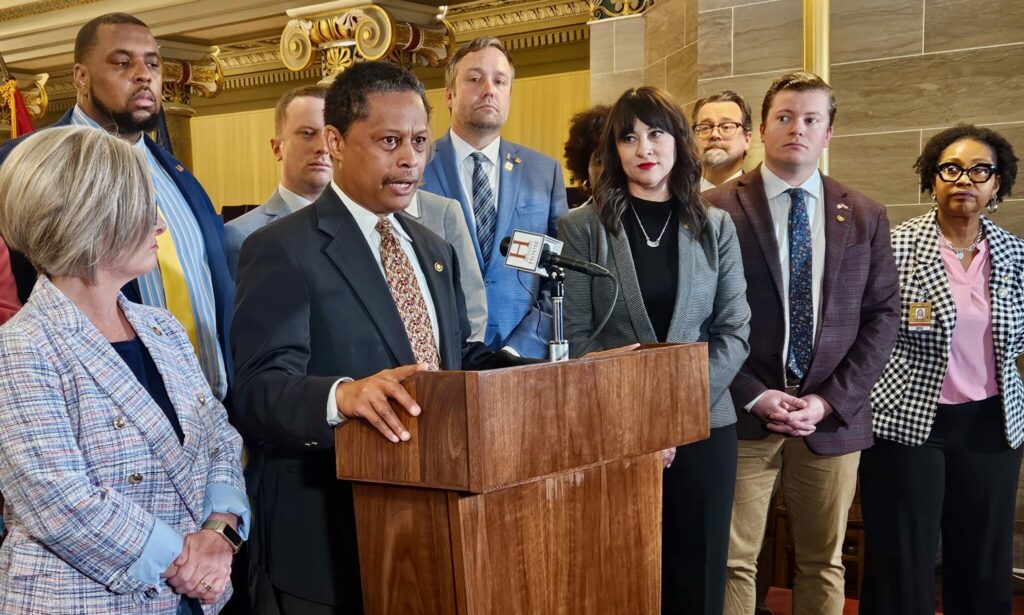Missouri House finishes work on $48 billion state budget plan

The Missouri House sent the state Senate a budget of almost $48 billion to fund state agency operations in the coming fiscal year, a spending plan almost certain to grow as the upper chamber adds more money for public schools and child care.
The 13 spending bills use about $2.1 billion less overall and $800 million less in general revenue than recommended by Gov. Mike Kehoe when he presented his budget plan in January. More than half of the general revenue savings are cuts to Medicaid spending based on newer estimates of enrollment in the fiscal year that begins July 1.
Some of the other reductions are due to paring back state employee pay raises, cutting spending lines where no money is actually available and shifting incomplete projects to a reappropriation bill that is not included on the bottom line.
The budget plan didn’t just cut money from Kehoe’s proposal. There were several small additions for state agencies, like $28 million for deferred maintenance on college campuses; extra pay raises for Missouri State Highway Patrol troopers and commercial vehicle inspectors at a cost of $8.4 million; and 20 new holistic defense social workers in the Office of Public Defender at a cost of $1.2 million.
There are also 105 earmarked items with a total cost of $170 million, including $142.7 million in general revenue. The projects range in size from $25,000 for a road project in St. Joseph to $19 million for a new state park in the district of House Budget Committee Chairman Dirk Deaton, a Republican from Noel.
“We’re proud to have found savings and efficiencies across state government,” Deaton said at a news conference after the House action. “We also continue to have a really historic surplus, although it is being drawn down, but still leaving $2 billion on the bottom line.”
State Rep. Del Taylor, a St. Louis Democrat, said talking about how much was cut doesn’t impress him.
“We don’t measure ourselves in dollars saved and oh, ‘I cut $100 million out of this budget and that budget,’” he said. “What we really need to be measuring ourselves on is, are we addressing the needs of our people with funding for those non-profit organizations that our state has partnered with.”

The state had a balance of $3.8 billion in the general revenue fund as of Monday, down from historic high of about $5.7 billion set in 2023. The budget on its way to the Senate spends $14.4 billion in general revenue, which would require about $900 million from the accumulated surplus if revenue meets expectations.
Democrats found a lot to like in the budget, even if they were not pleased with the outcome on school funding and child care subsidies.
“House Democrats were able to make a number of changes to the budget for the betterment of their communities and the state, and it was a refreshing change from what we’ve endured in recent years,” said House Minority Leader Ashley Aune of Kansas City.
Most of the 13 bills passed with fewer than 10 votes against them. The largest number of opposition votes came on the bills funding the Department of Elementary and Secondary Education and elected officials, where $50 million for private school tuition scholarship program called MOScholars is appropriated.
There is new anti-diversity, equity and inclusion language in the bill funding the Department of Higher Education and Workforce Development as well as long-standing language denying in-state tuition to undocumented immigrant students who live in the state. However, despite raising objections on the floor, many Democrats supported the bill as it passed 117-17.
State Rep. Betsy Fogle of Springfield, the ranking Democrat on the House Budget Committee, said Democrats had a tough choice on whether to support the higher education spending bill. The votes in favor of it were not traded for earmarks, she said.
“There’s no price act, no amount of money that would make the House Democrats sacrifice our values, our morals and our commitment to diversity, equity, inclusion in the state,” she said. “My calculation was, and always will be, how do I bring home the most investments to the most Missourians without sacrificing the values of the House Democratic Caucus?”
There is almost $500 million tied up in budget lines that are sure to get a lot of attention during Senate deliberations.
The largest is $300 million for the school foundation formula. Under the calculation establishing how much should be spent on public schools, the basic rate for state aid, called the state adequacy target, is $7,145 per pupil. The House budget plan only funds an adequacy target of $6,760 per student.
Kehoe did not include the increase in his budget and neither did the House. Senate Appropriations Committee Chairman Lincoln Hough of Springfield has said he will find the money.
One item Democrats wanted to eliminate is the $50 million appropriation for the MOScholars program. The program, expanded last year, has not attracted the donations expected and is the first time the state is making grants of tax dollars to pay tuition at private and parochial schools.
Hough has also said he intends to restore a cut to Kehoe’s budget for child care subsidies. Kehoe asked lawmakers to use $107 million of new federal funding for child care to revise how providers are paid. Instead of being paid based on attendance at the end of a month, providers would get their money at the beginning of the month based on the number of children enrolled.
The child care money isn’t in the budget, Deaton said, because it could become a cost to the general revenue fund.
“I really never even got to the point of, is this good public policy? Is this bad? Is this a better idea? Is this a better way to do it, or not?” Deaton said “We really never even got past the fiscal concerns of can we make this work year in and year out?”
The problems with the current program, plagued by late or missed payments since the launch of a new computer processing system, make the changes proposed by Kehoe essential, Fogle said.
“We sat in that budget hearing room for countless hours,” Fogle said, “listening to people cry and scream and express their frustration about our inability to do our job as a General Assembly and the department to get those dollars out the door.”
Miss Clipping Out Stories to Save for Later?
Click the Purchase Story button below to order a print of this story. We will print it for you on matte photo paper to keep forever.

